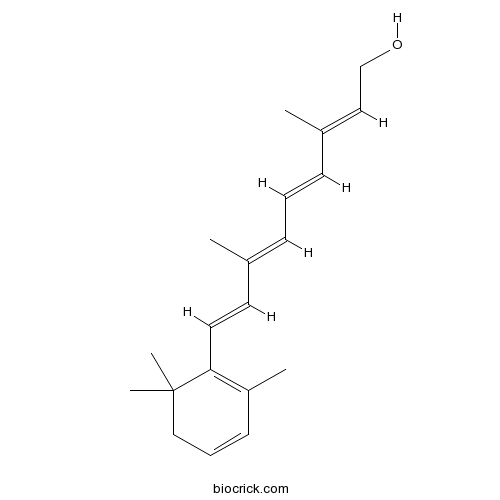Vitamin A2CAS# 11103-57-4 |

Quality Control & MSDS
3D structure
Package In Stock
Number of papers citing our products

| Cas No. | 11103-57-4 | SDF | Download SDF |
| PubChem ID | 6436043 | Appearance | Powder |
| Formula | C20H28O | M.Wt | 284.44 |
| Type of Compound | N/A | Storage | Desiccate at -20°C |
| Synonyms | 3-Dehydro Retinol;Dehydroretinol;3,4-didehydroretinol;all-trans-3,4-Didehydroretinol | ||
| Solubility | Soluble in Chloroform,Dichloromethane,Ethyl Acetate,DMSO,Acetone,etc. | ||
| Chemical Name | (2E,4E,6E,8E)-3,7-dimethyl-9-(2,6,6-trimethylcyclohexa-1,3-dien-1-yl)nona-2,4,6,8-tetraen-1-ol | ||
| SMILES | CC1=C(C(CC=C1)(C)C)C=CC(=CC=CC(=CCO)C)C | ||
| Standard InChIKey | XWCYDHJOKKGVHC-OVSJKPMPSA-N | ||
| Standard InChI | InChI=1S/C20H28O/c1-16(8-6-9-17(2)13-15-21)11-12-19-18(3)10-7-14-20(19,4)5/h6-13,21H,14-15H2,1-5H3/b9-6+,12-11+,16-8+,17-13+ | ||
| General tips | For obtaining a higher solubility , please warm the tube at 37 ℃ and shake it in the ultrasonic bath for a while.Stock solution can be stored below -20℃ for several months. We recommend that you prepare and use the solution on the same day. However, if the test schedule requires, the stock solutions can be prepared in advance, and the stock solution must be sealed and stored below -20℃. In general, the stock solution can be kept for several months. Before use, we recommend that you leave the vial at room temperature for at least an hour before opening it. |
||
| About Packaging | 1. The packaging of the product may be reversed during transportation, cause the high purity compounds to adhere to the neck or cap of the vial.Take the vail out of its packaging and shake gently until the compounds fall to the bottom of the vial. 2. For liquid products, please centrifuge at 500xg to gather the liquid to the bottom of the vial. 3. Try to avoid loss or contamination during the experiment. |
||
| Shipping Condition | Packaging according to customer requirements(5mg, 10mg, 20mg and more). Ship via FedEx, DHL, UPS, EMS or other couriers with RT, or blue ice upon request. | ||

Vitamin A2 Dilution Calculator

Vitamin A2 Molarity Calculator
| 1 mg | 5 mg | 10 mg | 20 mg | 25 mg | |
| 1 mM | 3.5157 mL | 17.5784 mL | 35.1568 mL | 70.3136 mL | 87.892 mL |
| 5 mM | 0.7031 mL | 3.5157 mL | 7.0314 mL | 14.0627 mL | 17.5784 mL |
| 10 mM | 0.3516 mL | 1.7578 mL | 3.5157 mL | 7.0314 mL | 8.7892 mL |
| 50 mM | 0.0703 mL | 0.3516 mL | 0.7031 mL | 1.4063 mL | 1.7578 mL |
| 100 mM | 0.0352 mL | 0.1758 mL | 0.3516 mL | 0.7031 mL | 0.8789 mL |
| * Note: If you are in the process of experiment, it's necessary to make the dilution ratios of the samples. The dilution data above is only for reference. Normally, it's can get a better solubility within lower of Concentrations. | |||||

Calcutta University

University of Minnesota

University of Maryland School of Medicine

University of Illinois at Chicago

The Ohio State University

University of Zurich

Harvard University

Colorado State University

Auburn University

Yale University

Worcester Polytechnic Institute

Washington State University

Stanford University

University of Leipzig

Universidade da Beira Interior

The Institute of Cancer Research

Heidelberg University

University of Amsterdam

University of Auckland

TsingHua University

The University of Michigan

Miami University

DRURY University

Jilin University

Fudan University

Wuhan University

Sun Yat-sen University

Universite de Paris

Deemed University

Auckland University

The University of Tokyo

Korea University
- Pioglitazone
Catalog No.:BCC4927
CAS No.:111025-46-8
- Muricatide
Catalog No.:BCN1780
CAS No.:111025-01-5
- 2-Amino-1-phenylethanol
Catalog No.:BCN1779
CAS No.:7568-93-6
- Efonidipine hydrochloride monoethanolate
Catalog No.:BCC7767
CAS No.:111011-76-8
- (-)-Dihydroquercetin
Catalog No.:BCN3370
CAS No.:111003-33-9
- Deacetylsalannin
Catalog No.:BCN4733
CAS No.:1110-56-1
- Methyl Laurate
Catalog No.:BCC8211
CAS No.:111-82-0
- 1-Heptylamine
Catalog No.:BCN1801
CAS No.:111-68-2
- Oleylethanolamide
Catalog No.:BCC7084
CAS No.:111-58-0
- Diethanolamine
Catalog No.:BCN1797
CAS No.:111-42-2
- Decanedioic acid
Catalog No.:BCN5996
CAS No.:111-20-6
- Squalene
Catalog No.:BCN5995
CAS No.:111-02-4
- Ruthenium Red
Catalog No.:BCC7067
CAS No.:11103-72-3
- Annonacin
Catalog No.:BCN4734
CAS No.:111035-65-5
- 2-(2'-Hydroxy-4'-methylphenyl)propionic acid
Catalog No.:BCN7980
CAS No.:111044-84-9
- Ginkgolic acid C17:1
Catalog No.:BCN5334
CAS No.:111047-30-4
- N-Benzoyl-2-hydroxy-2-phenylethylamine
Catalog No.:BCN1622
CAS No.:111059-46-2
- Fmoc-D-Lys(Trt)-OH
Catalog No.:BCC2594
CAS No.:111061-54-2
- Fmoc-Ser(Trt)-OH
Catalog No.:BCC3546
CAS No.:111061-56-4
- Dacomitinib (PF299804, PF299)
Catalog No.:BCC3683
CAS No.:1110813-31-4
- FERb 033
Catalog No.:BCC7701
CAS No.:1111084-78-6
- 14-Hydroxy sprengerinin C
Catalog No.:BCN2777
CAS No.:1111088-89-1
- NF 110
Catalog No.:BCC7404
CAS No.:111150-22-2
- PF-04880594
Catalog No.:BCC3998
CAS No.:1111636-35-1
Human cytochrome P450 27C1 catalyzes 3,4-desaturation of retinoids.[Pubmed:27059013]
FEBS Lett. 2016 May;590(9):1304-12.
In humans, a considerable fraction of the retinoid pool in skin is derived from Vitamin A2 (all-trans 3,4-dehydroretinal). Vitamin A2 may be locally generated by keratinocytes, which can convert vitamin A1 (all-trans retinol) into Vitamin A2 in cell culture. We report that human cytochrome P450 (hP450) 27C1, a previously 'orphan' enzyme, can catalyze this reaction. Purified recombinant hP450 27C1 bound and desaturated all-trans retinol, retinal, and retinoic acid, as well as 11-cis-retinal. Although the physiological role of 3,4-dehydroretinoids in humans is unclear, we have identified hP450 27C1 as an enzyme capable of efficiently mediating their formation.


